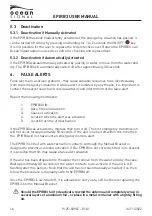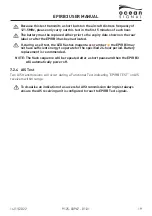
14/11/2022
912S-03967 - 01.01
5
EPIRB3 USER MANUAL
1.2 Return Link Service
The Galileo Return Link Service (RLS) is a free-of-charge global service available to
Cospas-Sarsat RLS compatible beacons. The new functionality, currently offered uniquely
by Galileo, enables a communication link that relays a Return Link Message (RLM) back to
the originating beacon through the Galileo Navigation Signal in Space.
The RLS feature is an indication on the EPIRB3 that confirms to the User that the distress
signal from the EPIRB3 has been localised by the Cospas-Sarsat system and is being
sent to the SAR authorities. It does NOT mean that a search and rescue mission has been
launched, but only confirms that the distress alert has been received by the Cospas-Sarsat
system and is being routed to the appropriate SAR agencies.
The RLS aims to send an acknowledgment to the beacon within 30 minutes following
activation (the response may not be received by the beacon for significantly longer).
RLS is an optional function and may not be permitted in all countries.
The full RLS specification can be found here:
https://gsc-europa.eu/sites/default/files/sites/all/files/Galileo-SAR-SDD.pdf
1.3 AIS System
AIS systems operate on VHF radio bands and transceivers are fitted to all commercial
shipping and an ever growing number of recreational vessels globally. Shortly after
activation, an AIS EPIRB device will activate an alarm on all AIS equipped vessels within
VHF range alerting them to the fact that a person is in the water needing assistance. Often
it is a vessel in the close vicinity of an incident that is able to react and effect a rescue
quicker than the emergency services.
Emergency service craft are fitted with AIS receivers allowing them to pinpoint a casualty in
the water more precisely than any other system.






































